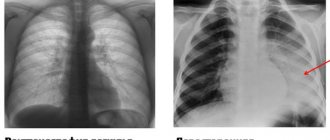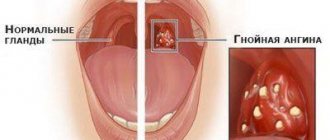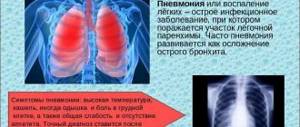Viral pneumonia
Viral pneumonia
Viral pneumonia is an acute inflammation of the respiratory tract of the lungs, caused by viral pathogens, occurring with a syndrome of intoxication and respiratory disorders. In childhood, viral pneumonia accounts for about 90% of all cases of pneumonia. In the structure of adult morbidity, bacterial pneumonia predominates, and viral pneumonia accounts for 4–39% of the total (persons over 65 years of age are more often affected). The incidence of viral pneumonia is closely related to epidemiological outbreaks of ARVI - their rise occurs in the autumn-winter period. In pulmonology, a distinction is made between primary viral pneumonia (interstitial with a benign course and hemorrhagic with a malignant course) and secondary (viral-bacterial pneumonia - early and late).
Causes of viral pneumonia
The range of pathogens causing viral pneumonia is extremely wide. The most common etiological agents are influenza A and B viruses, parainfluenza, and adenovirus. Persons with immunodeficiencies are more susceptible than others to viral pneumonia caused by the herpes virus and cytomegalovirus. Pneumonia initiated by enteroviruses, hantavirus, metapneumovirus, and Epstein-Barr virus are less commonly diagnosed. SARS-associated coronavirus is the causative agent of severe acute respiratory syndrome, better known as atypical pneumonia. In young children, viral pneumonia is often caused by respiratory syncytial virus, as well as measles and chickenpox viruses.
Primary viral pneumonia manifests itself in the first 3 days after infection, and after 3-5 days the bacterial flora joins, and the pneumonia becomes mixed - viral-bacterial. Persons at increased risk of developing viral pneumonia include young children, patients over 65 years of age, people with weakened immunity, cardiopulmonary pathology (heart defects, severe arterial hypertension, coronary artery disease, chronic bronchitis, bronchial asthma, emphysema) and others. concomitant chronic diseases.
Viruses are transmitted through airborne droplets when breathing, talking, sneezing, coughing; a contact-household route of infection through contaminated household items is possible. Viral particles penetrate into the respiratory sections of the respiratory tract, where they are adsorbed on the cells of the bronchial and alveolar epithelium, causing its proliferation, infiltration and thickening of the interalveolar septa, and round cell infiltration of the peribronchial tissue. In severe forms of viral pneumonia, hemorrhagic exudate is detected in the alveoli. Bacterial superinfection significantly aggravates the course of viral pneumonia.
Symptoms of viral pneumonia
Depending on the etiological agent, viral pneumonia can occur with varying degrees of severity, complications and outcomes. Inflammation of the lungs usually occurs from the first days of ARVI.
Thus, damage to the respiratory tract is a frequent companion to adenoviral infection. The onset of pneumonia in most cases is acute, with high fever (38-39°), cough, severe pharyngitis, conjunctivitis, rhinitis, and painful lymphadenopathy. The temperature with adenoviral pneumonia lasts a long time (up to 10-15 days), and is characterized by large daily fluctuations. Characterized by frequent, short cough, shortness of breath, acrocyanosis, variable moist rales in the lungs. In general, adenoviral pneumonia is distinguished by long-term persistence of clinical and radiological changes, a tendency to recurrent course and complications (pleurisy, otitis media).
The incidence of viral pneumonia against the background of influenza increases significantly during periods of epidemics of respiratory infection. In this case, against the background of typical symptoms of ARVI (fever, severe weakness, myalgia, catarrh of the upper respiratory tract), noticeable shortness of breath, diffuse cyanosis, cough with rust-colored sputum, wheezing in the lungs, and chest pain when inhaling appear. In children, general toxicosis and anxiety are expressed; vomiting, convulsions, and meningeal signs may occur. Influenza pneumonia is usually bilateral in nature, as evidenced by auscultatory findings and an x-ray picture (focal opacities in both lungs).
Mild cases of viral pneumonia caused by the influenza virus are characterized by moderate symptoms and end with recovery. Severe forms occur with constant high fever, respiratory failure, and collapse. Complications include influenza encephalitis and meningitis, otitis media, and pyelonephritis. The addition of a secondary bacterial infection often leads to the development of lung abscesses or pleural empyema. Death is possible during the first week of the disease.
Parainfluenza pneumonia most often affects newborns and young children. It is of a small-focal (less often confluent) nature and occurs against the background of catarrhal phenomena. Respiratory disorders and intoxication syndrome are moderate, body temperature usually does not exceed subfebrile values. Severe forms of viral pneumonia with parainfluenza in children occur with severe hyperthermia, convulsions, anorexia, diarrhea, and hemorrhagic syndrome.
A feature of respiratory syncytial pneumonia is the development of severe obstructive bronchiolitis. Damage to the lower parts of the respiratory tract is marked by an increase in body temperature to 38–39°C and a deterioration in general condition. Due to spasm and blockage of small bronchi with mucus and desquamated epithelium, breathing becomes sharply difficult and rapid, and cyanosis of the nasolabial and periorbital area develops. The cough is frequent, wet, but due to the increased viscosity of sputum, it is unproductive. With this type of viral pneumonia, attention is drawn to the discrepancy between intoxication (moderately expressed) and the degree of respiratory failure (extremely pronounced).
Enteroviral pneumonia, caused by the Coxsackie and ECHO viruses, occurs with scant physical and radiological data. In the clinical picture, concomitant meningeal, intestinal, and cardiovascular disorders come to the fore, making diagnosis difficult.
Diagnosis and treatment of viral pneumonia
A thorough study of the anamnesis, epidemiological situation, assessment of physical and laboratory-radiological data will help to correctly recognize the etiological form of pneumonia and identify the causative agent. Viral pneumonia usually develops during periods of epidemic outbreaks of acute respiratory viral infections, occurs against the background of catarrhal syndrome, and is accompanied by signs of respiratory failure of varying severity. On auscultation, fine bubbling rales are heard in the lungs.
X-rays of the lungs reveal an increased interstitial pattern and the presence of small focal shadows, often in the lower lobes. The study of sputum, tracheal aspirate or bronchial lavage using the fluorescent antibody method helps confirm the viral etiology of pneumonia. In the blood in the acute period, there is a fourfold increase in antibody titers to the viral agent.
A comprehensive assessment of objective data by a pulmonologist will exclude atypical pneumonia, aspiration pneumonia, bronchiolitis obliterans, infarction pneumonia, bronchogenic cancer, etc.
Hospitalization for viral pneumonia is indicated only for children under 1 year of age, patients in the older age group (over 65 years old), and those with severe concomitant diseases (COPD, heart failure, diabetes mellitus). Patients are prescribed bed rest, plenty of fluids, and fortified, high-calorie foods.
Etiotropic therapy is prescribed depending on the viral pathogen: rimantadine, Tamiflu, Relenza - for influenza pneumonia, acyclovir - for herpes viral pneumonia, ganciclovir - for cytomegalovirus infection, ribavirin - for respiratory syncytial pneumonia and hantavirus infection, etc. Antibacterial agents are added only in cases of mixed pneumonia or the development of purulent complications. Expectorants and antipyretics are used as symptomatic treatment. In order to facilitate the discharge of sputum, medicinal inhalations and drainage massage are performed. In case of severe toxicosis, intravenous infusion of solutions is carried out; with the development of respiratory failure - oxygen therapy.
Symptoms of viral pneumonia
Cough is a characteristic symptom of pulmonary diseases.
The symptoms of viral pneumonia depend on the virus acting on the body. As a rule, the lungs begin to become inflamed from the very first days of the onset of a cold.
A viral agent (usually an adenovirus) affects the upper parts of the respiratory tract, gradually descending to the lungs. Pneumonia begins, usually in an acute form with fever, cough, severe pharyngitis, conjunctivitis and rhinitis. The high temperature during the disease lasts a long time, up to two weeks, and tends to fluctuate at different times.
Pneumonia, which is of viral origin, is characterized by frequent, short cough, shortness of breath, bluish skin, and pulmonary rales of varying severity. In general, adenoviral pneumonia is characterized by long-term persistence of symptoms, a tendency to relapse and complications, such as pleurisy and otitis media.
The number of registered cases due to influenza becomes many times greater during periods of epidemics of viral infections.
In addition to the usual signs of the flu, there is also a wet cough and pain when breathing. Children experience toxicosis, restlessness, vomiting, and convulsions. As for viral influenza pneumonia, it often occurs on both sides.
When pneumonia occurs without complications, which is provoked by the flu, the symptoms are moderate, and the disease ends with the patient’s complete recovery. In severe cases, there is constant fever, lack of air, and collapse.
Complications include meningitis, otitis media, pyelonephritis and influenza encephalitis. If a secondary infection caused by bacteria occurs, lung abscesses or pleural empyema often occur. If left untreated, this case may result in death.
Parainfluenza pneumonia mainly occurs in young children. It spreads in small patches, less often they merge. The course is characterized by catarrhal symptoms. Respiratory disorders and intoxication are mild. The temperature rarely rises above low-grade fever. In severe cases, the child may develop hyperthermia, convulsions, anorexia, bowel dysfunction, and hemorrhagic syndrome.
Viral respiratory syncytial pneumonia is characterized by the fact that obstructive bronchiolitis can develop in severe form. The damage to the respiratory organs and their lower parts can be understood by a very elevated temperature, as well as by the fact that the general condition is deteriorating. Breathing becomes heavy and frequent due to spasms and blockage of small vessels. In addition, cyanosis appears in various parts of the face. The cough becomes clear and moist, but the viscous sputum does not come out well. Intoxication is not severe, but the lack of oxygen is active.
Viral pneumonia treatment
An unknown virus is gaining momentum in China. At least that's what the newspaper headlines say . About 60 people have already died from the virus, and about 200 more are in quarantine. Doctors suggest that the cause of the unknown disease in China is a virus that causes viral pneumonia. Next, we’ll look at whether this disease is dangerous and how it differs from a bacterial one.
Link to news and description of the Chinese virus that causes pneumonia: https://polit.ru/article/2020/01/07/ps_viral_pneumonia/
Doctors do not know which virus caused the pneumonia. At this stage, there is no specific treatment for the virus and viral pneumonia. Doctors treat empirically and symptomatically. This means that medications only relieve symptoms of the disease.
Symptomatic treatment for viral pneumonia includes antipyretic drugs (ibuprofen, paracetamol).
What can cause viral pneumonia
Most often, viral pneumonia is caused by influenza types A and B, and less commonly by adenoviruses, parainfluenza, and measles. Sometimes pneumonia can occur due to the action of enteroviruses or the Epstein-Barr virus.
It is young children, up to 5-7 years old, who are most susceptible to viral pneumonia. This complication often develops in individuals with primary immunodeficiencies.
How to distinguish a virus from a bacteria
Based on the clinical picture of the disease, it is difficult to guess what exactly caused the pneumonia. The symptoms of the diseases are the same. There is a cough, shortness of breath, and sometimes chest pain.
You can guess the nature of pneumonia using a general blood test. If there are a lot of leukocytes in it, namely an increased number of neutrophils, then the infection may be bacterial. In a viral infection, lymphocytes often predominate. But a blood test alone cannot determine whether pneumonia is viral or bacterial. It is also impossible to determine the nature of the infection using x-rays.
But this determination method takes time (from 5 to 10 days). During this time, doctors prescribe empirical treatment: infusions to fight viruses and antibiotics to fight suspected bacteria.
If rapid methods determine that the causative agent of the disease is the influenza virus, then there are etiological drugs that kill the virus. These include oseltamivir and zanamivir.
It is important that viral pneumonia progresses quickly, so there is no time to wait; it is necessary to prescribe treatment from the first days after an x-ray or computed tomography.
Viral pneumonia - clinical picture
Symptoms of viral pneumonia are often mistaken for a common cold or flu. Indeed, the clinical picture of these anomalies is almost identical.
The first manifestations of pneumonia include the following:
- high intensity headache;
- chills, increased body temperature;
- nasal congestion, severe rhinitis;
- chest pain, breathing problems, shortness of breath;
- signs of intoxication - manifested in the form of damage to the digestive system, nausea and vomiting;
- cough without sputum production;
- body aches, weakness in muscle tissue, pain when moving;
- redness of the eyes;
- increasing moist rales - they can be heard when listening with a phonendoscope;
- blue extremities – caused by coughing attacks;
- general weakness - this condition leads to loss of ability to work.
Dangers of pathology
Viral pneumonia in children or adults is often complicated by the addition of a bacterial infection.
Pneumonia is also dangerous because respiratory failure rapidly increases, which, without treatment, is highly likely to develop into pulmonary edema and death. This happened in China in 2020, which is reminiscent of the first viral pneumonia pandemics, for example, the Spanish flu.
Treatment of viral pneumonia
Viral pneumonia must be treated quickly. All kinds of methods of “flooding” the body are included in the treatment, namely infusion with saline solution or Hartmann, Ringer-Locke solutions. They are supplemented with diuretics such as Furosemide to quickly flush out fluid.
In 99% of cases, a patient with pneumonia of any origin will be prescribed antibiotics. This is done for “reinsurance”. It is impossible to accurately and quickly determine what type of pneumonia is: viral or bacterial, or maybe mixed. Therefore, to treat this disease, patients are prescribed antibiotics from the group of protected penicillins, either the latest generation of macrolides, or third-generation cephalosporins.
Antibiotic therapy lasts on average 7-10 days.
An unknown virus in China is also being treated empirically. But if scientists can isolate its genetic material, they will try to create a vaccine or find an acceptable treatment method. Diagnostics is carried out using the PRC method with analysis of the genetic material of patients.
The most common causative agents of viral pneumonia
The provocateurs of the disease are:
- smallpox virus;
- influenza type B and A;
- adenovirus;
- syncytial respiratory virus;
- parainfluenza;
- herpes of the 1st and 3rd types;
- measles virus
Children's viral pneumonia develops mainly due to parainfluenza and influenza viruses. One uncured disease leads to another more serious disease. The disease is also caused by an adenovirus. Children with weakened immune systems are at greatest risk. The child may experience excruciating pain in the chest and aching joints.
Viral-bacterial (combined) pneumonia occurs due to adenovirus. It enters the body through the mucous membranes of the upper respiratory tract. The mucous membrane of the eyes is often affected and conjunctivitis appears. With weakened immunity, the virus descends lower into the bronchi and then penetrates the lungs.
Cytomegalovirus provokes the appearance of cytomegalovirus pathology. This disease is diagnosed in newborns and children under one year of age. The infection is also often found in patients with HIV.
The disease caused by chickenpox is called chickenpox or varicella. It appears due to the penetration of the virus into the lungs and bronchi.
The incubation period for viral pneumonia lasts several days. In each case, the period is individual - from 12 hours to two months. Often the onset of the disease is preceded by the following phenomena:
- reduction in the synthesis of substances such as immunoglobulins, etc.;
- development of immunoinflammatory reactions;
- accumulation of metabolic products and stagnation of blood in the capillaries of the lungs.
Symptoms of viral pneumonia
It is very difficult to understand that pneumonia is developing. There are often cases when ARVI is treated and thereby starts a serious illness.
The initial signs of viral and bacterial pneumonia are:
- chills;
- swollen lymph nodes;
- Pain in the eyes;
- nausea, vomiting;
- dry cough (sometimes sputum occurs);
- runny or stuffy nose;
- muscle and joint pain;
- weakness;
- pain in the lungs or bronchi.
An abortive course of the disease is possible, caused by a local focus of infection in the lung tissue. There are almost no symptoms. A slight cough may occur. Body temperature rises to 38°C. General health remains virtually unchanged.
The symptoms of viral and bacterial pneumonia can only be recognized by a competent doctor. The main thing is to seek help as quickly as possible.
Attention! The disease is dangerous. Don't take risks and don't self-medicate.
How does psittacosis manifest?
Psittacosis is also a focal inflammation of the lungs. It can be contracted from different birds (chickens, some types of parrots or pigeons). The causative agent of this disease is a bacterium from the chlamydia family. It can persist in the external environment for up to three weeks and develops intracellularly in humans.
Infection occurs through inhalation of dust particles in the immediate vicinity of the place where the birds are kept, where the bacteria is contained. Most often it spreads in winter. At the same time, an infected person does not pose a danger to others; he will not be a carrier of the disease.
People who are in direct contact with birds (on poultry farms, meat processing plants, bird trainers) are most susceptible to the disease. The incubation period is one to two weeks and is asymptomatic.
Signs characteristic of psittacosis are as follows:
- A sharp increase in temperature up to 40 ° C.
- Chest pain appears after 2 days.
- Pain and aches in muscles and joints.
- Vomiting and nausea.
- Appearance of a rash.
- Bleeding from the nose associated with damage to the mucous membrane.
- Mild runny nose and sore throat.
- Headache.
- Insomnia.
- Enlarged liver.
- Frequent mood swings (from depressive to euphoric).
Antibiotics are prescribed during treatment. This type of pneumonia has one peculiarity: re-infection is possible several weeks after recovery. The only prevention is to limit contact with birds and wear special respiratory masks.
The symptoms of pneumonia in childhood are the same as in adults. If the child is too young to complain about his condition, you should pay attention to the frequency of his breathing and the appearance of shortness of breath against the background of general signs of a cold.
Complications
The danger of viral pneumonia lies in its unpredictability. The following complications may occur:
- significantly increased body temperature, fever;
- sepsis;
- inflammation of the heart muscle;
- meningitis;
- oxygen deficiency;
- toxic-infectious shock;
- swelling and abscess of the lungs;
- otitis.
Attention! If pus appears in the coughed up sputum, it means that a secondary bacterial infection has occurred.
Respiratory failure often occurs. The person begins to breathe intensely, arterial and partial pressures increase, and then sharply decrease, which can result in coma.
Sometimes toxic shock occurs. The cardiovascular system malfunctions. Severe pain occurs throughout the body and in the head. Consciousness becomes confused. Such complications are usually observed in young children.
Some patients experience kidney and liver failure. In this case, immediate hospitalization is indicated. The patient must be constantly monitored by medical professionals. It is important to constantly monitor breathing, blood pressure and other vital signs.
Diagnostics
Timely diagnosed viral pneumonia in children and adults is easier to treat. Severe consequences in this case occur extremely rarely. To make an accurate diagnosis, the doctor studies the epidemiological situation and the person’s medical history. The patient undergoes the following examinations:
- laboratory sampling;
- examination of sputum, tracheal aspirate or bronchial lavage using the fluorescent antibody method;
- X-rays of light.
There are two stages of the disease. Primary is determined by clinical signs and on the basis of laboratory information, secondary (viral pneumonia) is detected as a complication of a cold infection against the background of the immunity of the causative virus to the therapy.
What viruses cause this disease?
Viral pneumonia is caused by various types of viruses. Often the lungs are affected by the common flu viruses, more precisely, by its subtypes A and B. Also, a large number of cases are caused by the respiratory syncytial virus, abbreviated RSV. In children, this disease is most often caused by parainfluenza, varicella zoster and measles viruses. Rarer pathogens in children and adults are adenoviruses, atypical pneumonia viruses and metapneumoviruses. Very rarely, pneumonia in adults can be caused by herpes viruses, chickenpox, and enterovirus.
What and how to treat viral pneumonia?
Viral inflammation of the airways and lungs is treated with antiviral medications.
Adults and children are prescribed different doses, which are selected by the doctor. Young patients are often prescribed immunomodulators. Also recommended:
- non-steroidal anti-inflammatory drugs (paracetamol, ibuprofen, etc.), which relieve pain and lower temperature;
- expectorant medicine (acetylcysteine, ambroxol, etc.), thinning and removing sputum;
- antitussive medications, which are prescribed if the cough is painful;
- etiotropic therapy (lasts 7-14 days), which uses antiviral drugs;
- immunomodulatory treatment to activate the immune system.
- physiotherapy to help improve the respiratory functions of the lungs and normalize metabolic processes.
For mild viral pneumonia, treatment is possible at home. If the disease is severe, it is important to isolate the patient from society. A medical institution must have the ability to carry out oxygenation (oxygen saturation) of blood and mechanical ventilation (artificial pulmonary ventilation).
Treatment of severe viral pneumonia in adults and children requires a clear action plan. It is forbidden to resort to traditional methods, but in addition to medications you can drink tea with linden, raspberries, coltsfoot, mint, and rose hips.
The duration of treatment is determined individually. The doctor takes into account clinical data and the results of a medical examination. The effectiveness of treatment for viral pneumonia depends on the following factors:
- level of complexity of the pathology at the time of diagnosis;
- state of immunity;
- the type of virus that caused the disease;
- patient's reaction to medications used.
Attention! For a speedy recovery, it is necessary to observe bed rest. You also need to drink clean water in large quantities.
Basic drugs for the treatment of viral pneumonia
To treat specifically complicated forms of ARVI (plus viral pneumonia), antiviral drugs are used:
- Oseltamivir;
- Zanamivir;
- Ingavirin.
The drugs can also be used to prevent ARVI. Children and adults use drugs in different doses, which are selected by the attending physician.
Treatment with antiviral drugs should begin at the first symptoms of ARVI in order to avoid dangerous complications such as pneumonia!
Antibacterial drugs are prescribed, since pneumonia can be mixed (bacterial-viral):
- cephalosporins 3, 4 generations;
- fluoroquinolones 3, 4 generations;
- carbopenems.
Patients with severe immunodeficiency conditions (HIV infection) may be prescribed antifungal drugs (Voriconazole, Capsofungin, etc.).
Immunomodulators are prescribed to maintain immunity; this is especially widely used in the treatment of children:
- Viferon;
- Grippferon;
- Kagocel;
- Pentaglobin;
- Galavit.
Severe viral pneumonia must be treated in a hospital setting in an intensive care unit, where it is possible to perform mechanical ventilation (artificial pulmonary ventilation) and oxygenation (oxygen saturation) of the blood.
Prognosis and prevention
Usually, after 14 days, bacterial and/or viral pneumonia ends in recovery. In 30-40 percent of patients, a protracted (3-4 weeks) course of the disease is observed. Clinical and radiological changes persist, and the disease becomes chronic.
The development of the disease depends on the patient’s immune resistance to the virus. For this reason, it is important to correctly diagnose the disease in the early stages.
Attention! People rarely die from viral pneumonia. Elderly people and young children are at risk.
Prevention of adult and childhood viral pneumonia involves taking the following measures:
- periodic intake of vitamin complexes;
- regular hardening;
- personal hygiene;
- systematically carrying out wet cleaning in the house and regular ventilation of the room;
- rejection of bad habits;
- lack of contact with patients with respiratory infections;
- if necessary, use personal protective equipment (masks);
- breathing exercises;
- timely vaccination;
- taking antiviral medications and immunomodulators for prevention;
- playing sports;
- good nutrition;
- get enough rest each day.
Attention! Failure to see a doctor in a timely manner is the main reason for the development of viral pneumonia, so at the first symptoms you should go to a medical facility. It is also important to follow your doctor's instructions.
Please share this material on social networks. This way, even more people will learn what the symptoms of the most dangerous pathology are - viral pneumonia.
What can cause the disease?
Today there are a sufficient number of different methods of infection, on which the severity of the disease depends. The weaker the immune system, the higher the likelihood of infection entering the body and developing an inflammatory process.
The main irritant and cause of pneumonia is a virus. Therefore, the viral form of pneumonia is divided into:
- atypical;
- flu;
- psittacosis.
If the inflammation was caused by the influenza virus, then the incubation period will last no more than 2.5 days. If a child is infected, pneumonia may appear a week later.
It is very important to have an idea of the duration of the incubation period, especially for parents. At the development stage, the disease may not manifest itself, but when the first symptoms appear, this indicates that the incubation period has already passed and the bacteria have attacked the body. Therefore, it is necessary to move on to the fight against them.
Atypical lung lesions
This type of disease is caused by the following bacteria:
- chlamydia;
- mycoplasma;
- legionella;
- viruses.
Infection often occurs in children's groups, which is transmitted by airborne droplets. The incubation period is 3-10 days.
Symptoms that occur with an atypical form of inflammation:
- dryness in the upper respiratory tract;
- temperature does not exceed 38 degrees;
- dry cough;
- tickle in the throat;
- shortness of breath at rest;
- headache;
- weakness in the body.
These symptoms are often confused with a cold. Therefore, a specialist rarely makes a diagnosis without an x-ray.
Severe atypical pneumonia occurs rarely. Often its course is mild to moderate.
Influenza form
Pneumonia occurs as a result of influenza. When the body is weakened, viruses and bacteria actively multiply (Staphylococcus aureus, Escherichia coli, pneumococci) which attack it. This type of disease refers to focal lesions.
Signs of influenza illness include:
- increased temperature up to 40 degrees;
- headache;
- chills;
- whole body aches;
- dyspnea;
- runny nose;
- cough with bloody sputum;
- pressing pain in the sternum.
Primary signs of pneumonia occur along with the flu. Quite rarely they are late, without differing from each other.
Such pneumonia can have a severe course with swelling of the organs. Frequent cases of death. For this reason, treatment of this disease is carried out using antibacterial agents. It is extremely dangerous to treat yourself at home; this can lead to various complications.
Psittacosis
It is a focal inflammation of the respiratory system. Infection can occur from a variety of birds. The causative agent of pneumonia is a bacterium that belongs to the chlamydia family. It can survive in the external environment for at least 3 weeks. It develops in humans inside cells.
A person becomes infected by inhaling dust particles near the location of birds where the pathogen is present. Often the bacterium develops in winter. After infection, a person does not pose a danger to others; he is not a carrier of the disease.
People who come into contact with birds are often susceptible to this infection. The incubation period of the disease is 1-2 weeks with an asymptomatic course.
Symptoms that occur with psittacosis:
- rapid rise in temperature to 40 degrees;
- pain in the sternum after 2 days;
- pain and aches in muscles, joints;
- vomit;
- nausea;
- the occurrence of rashes;
- nosebleeds;
- sore throat;
- slight manifestation of a runny nose;
- headache;
- insomnia;
- the liver enlarges;
- mood changes often.
Treatment is carried out with the prescription of antibiotics.
A feature of this type of pneumonia is possible re-infection 2 weeks after recovery. Prevention consists of limiting contact with infected birds and wearing special masks.
Physiological features of the course
With general symptoms of malaise, cough and high body temperature, it is important to correctly identify the disease in order to begin self-treatment or go to the hospital. A number of diagnoses cannot be transferred outside the hospital walls, so it is necessary to immediately recognize the first manifestations. In this article we will talk about viral pneumonia - what it is, what symptoms appear, how to deal with the disease.
Pneumonia is a lesion of the respiratory tract of an infectious nature, caused by respiratory viruses - influenza, adenovirus, enterovirus, etc. The pathogen penetrates by airborne droplets, enters the nasopharynx, where it encounters numerous barriers. But a weakened immune system cannot fight the attack of an aggressive environment, so it misses the infection. It is localized in the larynx, then, with untimely treatment and complications, it descends into the bronchi and lungs, causing fever, sputum production and cough.
Infection statistics
Among the pediatric segment, of all patients diagnosed with pneumonia, 90% have a viral etiology. This is due to their constant contact with potential carriers of the virus - in educational institutions, on the streets, in hospitals.
For adults, the most dangerous age is after 50-60 years. The weakened immune system of older people cannot protect against an epidemic or accidental contact with a sick person. The disease may have a latent form, that is, be asymptomatic, but the patient in this case is still a carrier of the infection - this happens in people with excellent immunity.
The highest frequency of cases was recorded during periods of influenza and ARVI epidemics. This occurs during the cold season - late autumn, winter and early spring. This is facilitated by:
- hypothermia of the body, especially frozen feet;
- low amount of vitamins and microelements from food;
- frequent colds.
On average, therapy takes 2-3 weeks, but lack of treatment can lead to serious consequences - complications, chronic form or death.
Causes of viral pneumonia
The method of spread of the pathogen is airborne and household, so people at risk are those who:
- live in the same room with the patient;
- have frequent contact with the patient;
- work in a clinic or regularly visit a hospital for other reasons;
- are in crowded places during the epidemic - at school, in a large shopping center.
You can become infected:
- if the patient sneezed or coughed;
- when kissing;
- due to the use of personal hygiene products and towels alone.
The infection lives on things for several hours. That is why doctors recommend regular ventilation in the room, as well as quartzing it with ultraviolet light.
Inflammation of a viral nature can be caused by viruses:
- influenza, strains A and B, parainfluenza;
- adenovirus;
- herpes;
- cytomegalovirus;
- enterovirus;
- hantavirus;
- metapneumovirus;
- Epstein-Barr;
- coronavirus;
- measles;
- chicken pox.
The pathogen enters through the upper pathways, then descends below and infects the cells of the pulmonary epithelium. The tissues become inflamed, and the production of exudate - mucus - begins. It fills the lungs, making it difficult for the patient to breathe. The most complex cases are the result of bacterial infection on top of the influence of a viral infection. This leads to suppuration.
Risk factors are:
- diseases of the cardiovascular system;
- weakened immunity, state of immunodeficiency;
- chronic pathologies of the respiratory tract;
- tumors, benign or malignant neoplasms;
- age over 60 and under 16.
Treatment
All viral diseases are treated only with antiviral drugs. Prescribing antibiotics is useless. Thus, viral pneumonia caused by influenza viruses is treated with Tamiflu and Relenza. Herpes and chickenpox viruses are sensitive to acyclovir. Cytomegalovirus to ganciclovir. Ribavirin is prescribed in the case. When infected with other viruses, there is no etiotropic treatment (aimed at destroying the pathogen). In these cases, the emphasis is on improving the immune system and eliminating symptoms of the disease. Treatment is prescribed only by a doctor!
Symptoms of viral pneumonia in adults - how the pneumonia virus manifests itself
During the incubation period (3-5 days), the disease manifests itself against the background of concomitant diseases of the larynx and nasopharynx:
- pharyngitis;
- laryngitis;
- sinusitis;
- sinusitis.
This affects the fact that not every patient begins to suspect the disease. Manifested by the following symptoms:
- Pain in the chest area - a feeling that the ribs are bursting from the inside, it becomes difficult to take a deep breath. This is especially true when lying down.
- Cough with wheezing, but without sputum production. This is not a dry tickle, but a hysterical urge that can last a minute or two, accompanied by a feeling of suffocation and lack of air.
- High body temperature during viral pneumonia can exceed 39 degrees and persist throughout the entire course of treatment. Doesn't respond well to antipyretics. Accompanied by body aches, malaise, fever or heat, and in special cases – a delirious state.
- Painful sensations in the throat can be of different natures depending on concomitant diseases. This may be inflammation of the vocal cords, pharyngeal tonsils or tonsils with purulent discharge or plaque on the tongue and palate. The cervical lymph nodes may also be inflamed. Redness and inflammation in the oral cavity can be relieved with the help of topical medications - aerosols, lozenges, rinses and inhalations.
- When pathogens are rotavirus or ARVI virus, nasal discharge may begin, sinusitis, rhinitis or sinusitis may worsen. Then viral pneumonia in adults will be accompanied by the following symptoms: nasal congestion; active secretion of mucus; spasms in the sinus area; purulent discharge.
- Pain in all muscles of the body.
- Painful sensations in the head can be in different parts of the head - in the front part, if the cause is a runny nose, in the neck and jaw area, if the lymph nodes are inflamed.
- Difficulty breathing is the main symptom, which is more pronounced when the body is lying down at night and in the morning when waking up from sleep. Difficulties arise due to the accumulation of exudate in the lungs and due to diseases of the upper respiratory tract - pharyngitis, tonsillitis, adenoiditis, which prevent the easy passage of air. In dangerous cases, when there is a risk of suffocation, the patient is helped mechanically - a breathing tube is inserted into the larynx. For a child, difficulty breathing is the first reason for hospitalization.
- Loss of appetite due to difficulty swallowing.
- Vomiting - appears after 5-6 days, when signs of intoxication appear.
- Pressure or ringing in the ears.
- Shortness of breath when walking.
At the first symptoms, go to the hospital. Remember that self-medication can lead to complications. Untimely treatment will turn the acute form into a chronic one, which will be much more difficult to eradicate. In some cases, hospitalization is necessary. Some causes, such as neoplasms, cannot be recognized without a thorough medical examination. Their therapy is surgical, and without the appropriate procedure, a benign tumor can lead to a malignant one, so be careful about your health and contact a medical facility at the first signs.
Features for different types of disease
Medical experts have proven that the lower the immunity, the faster the infection penetrates the body. The main irritant and basis for the development of pneumonia is a virus. The viral form of pneumonia is divided into several types:
- Atypical. The disease develops under the influence of the following types of bacterial cells: chlamydia, mycoplasma. It is more often possible to get sick with this form in children's groups through airborne droplets. The disease will occur with the following symptoms: body temperature rises to 38 degrees, discomfort in the throat and dry cough, frequent shortness of breath, lethargy and headache. The symptoms are similar to a common cold, so the doctor diagnoses the inflammation only after an x-ray.
- Flu-like. Develops as a consequence of influenza. The fact is that during the disease in question the body is weakened, and viruses actively attack it. The influenza form of pneumonia is considered focal and is characterized by the following symptoms: body temperature up to 41 degrees, headache, chills and aches, painful squeezing sensations in the chest, constant shortness of breath, severe cough with sputum, runny nose. The disease can be severe and accompanied by swelling of the organs. Treatment should proceed with the use of antibiotics prescribed by the attending physician.
- Psittacosis. This is a focal inflammation of the respiratory system. You can get an infection with the bacterium chlamydia. You can become infected by inhaling air containing dust particles in areas where there is a significant concentration of birds. Once the infection enters the respiratory tract, the patient does not pose a danger to the environment, since it is not contagious. Incubation time lasts up to 14 days. After this time, the main signs of the disease begin to appear: high body temperature, painful sensations in the sternum when breathing, constant nausea and vomiting, incessant headache and body aches, changes in mood, sore throat, nosebleeds and slight mucous discharge from the nose. . The peculiarity of this form of the disease is the possibility of re-infection some time after the illness.











